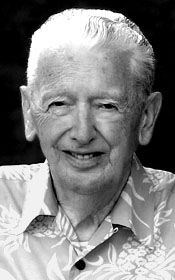When George Creuzot decided to build a school for mentally-challenged children in one day, nobody doubted he would get it done.
They started at 3 a.m. on the longest day of the year, June 21, 1959, and by 5:45 p.m., the Aurora School on Gillette Street was finished, 15 minutes ahead of time. The Kiwanis Club project still stands on the site of Harwin elementary school as one of the legacies of a man who helped change the face of Prince George's residential housing industry.
"He was so proud of that school," said Creuzot's granddaughter Trisha Andrews. "He told that story a lot."
Creuzot died Wednesday in Vernon at age 95, leaving behind five children, 12 grandchildren and 28 grandchildren, all part of close family he considered his greatest accomplishment.
"I just don't think there was a better grandfather," said Andrews, who has fond memories of spending summers at the Bednesti Lake cabin George and his wife Ruth owned on a 47-acre property he received as payment for a building project.
"He always stressed how important family was and that you can't go anywhere in life if you don't have a family to rely on. It just made us feel special. He was diplomatic and he understood people."
Known for his gentle nature, his sense of humour, his love of hockey, and his patience in sharing his knowledge of building, he inspired his sons, nephews and grandchildren to become builders themselves, while the women of the family did their part running the offices. Like George, they worked hard to keep up the reputation of building quality homes which continues today in the younger Creuzot generations.
"He was a good teacher for a lot of us who grew up in the industry," said Gary Creuzot, George's nephew. "He started a long line of builders. He left quite a legacy."
George moved to Prince George with his family in September 1951 to achieve his dream of starting his own construction company. Having grown up on a farm near Alsask, Sask., he was well-schooled in learning the meaning of an honest day's work. At the time, the city had just 4,500 residents and banks did not lend money for mortgages. If people wanted a house, they had to pay for it with the money up front. Through his efforts in lobbying the federal government to provide financing for housing loans, the rules for homeowners changed to allow people to get into a house with a down payment. George operating the construction end of the business with the Central Contracting Company, while his brother Henry looked after the homeowner loans.
George's reputation for quality work preceded him and back in the 50s he could get a building plan he'd sketched out on a piece of paper on a job site approved on the spot by an inspector. He recognized the need to get builders and tradespeople working together to raise the profile of the local industry, uphold quality standards, and build relationships within the industry that ensured a steady supply of qualified carpenters, electricians, plumbers and masons that ensured building projects were completed on time. So in February 1958, he and Dick Foxcroft formed the Prince George Contractors Association.
With George as president, the 12-member the group went to work immediately on pressuring the provincial government to release information on building projects that would allow Prince George builders to prepare their bids. That led to the formation of the Prince George Builders' Exchange.
In the 50s, a residential water supply was not a city-supplied service and Creuzot rounded up enough volunteers and tradesmen to dig the roads and install the pipes needed to bring water to homes in the Carney Street/Nechako area. In 1954 he organized a petition that eventually convinced the City of Prince George to take over that task as part of its infrastructure commitments.
A lot of the homes in the Westwood subdivision were built by Creuzot, and he named some of the streets of the area after family members -- Fern, Melody, Denise, Nicole and Christopher.
In 1954, Creuzot gathered a group of tradesmen to start Central Homes, building pre-fabricated wall panels, roof trusses, and concrete forms to help speed up the home construction process. Winter didn't stop them either, they worked even on days when the mercury plunged to -48 F. He built schools, service stations and houses in Vanderhoof, Houston, Mackenzie, Endako, Burns Lake, and Williams Lake.
In 1964, with three pulp mills in the planning stages for Prince George, housing construction boomed and to keep up with the demand, tradesman had to specialize and builders were forced to contract out some of the trades. In response, Creuzot formed the Prince George Home Builder's Association to continue to draw the building community together.
George lost his wife Ruth of 60 years in a car accident near Clinton in 2000. He suffered several heart attacks in his life and also battled cancer. He moved back to Vernon four years ago and was in failing health for several years leading up to his death.
His funeral service will be held on Thursday at 1 p.m., at Westwood Mennonite Brethren Church, 2658 Ospika Blvd.



